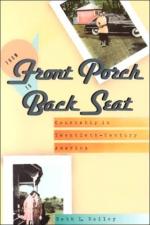
|
| Name: _________________________ | Period: ___________________ |
This test consists of 15 multiple choice questions and 5 short answer questions.
Multiple Choice Questions
1. In the book’s Introduction, Beth Bailey argues that the results of the sexual revolution have not been uniformly what?
(a) Positive.
(b) Negative.
(c) Radical.
(d) Political.
2. According to the author in Chapter 2, "The Economy of Dating,” individuals could start “going steady” at what age following World War II?
(a) 14.
(b) 17.
(c) 18.
(d) 12.
3. By what year did the word “date” enter the vocabulary of the middle class, according to the author in Chapter 1, "Calling Cards and Money"?
(a) 1952.
(b) 1937.
(c) 1928.
(d) 1910.
4. According to the author in Chapter 3, "The Worth of a Date,” simply having a date indicated what?
(a) Experience.
(b) Friendship.
(c) Success.
(d) Failure.
5. According to the author, what settings were often the trend-setters in courtship trends?
(a) Restaurants.
(b) Movie theaters.
(c) College campuses.
(d) Churches.
6. The average marriage age did what after World War II?
(a) Increased significantly.
(b) Dropped significantly.
(c) Increased slightly.
(d) Stayed the same.
7. Where was Beth Bailey teaching when the book was written?
(a) Harvard University.
(b) Rutgers University.
(c) Temple University.
(d) Yale University.
8. In what decade did the Great Depression begin?
(a) 1950s.
(b) 1900s.
(c) 1930s.
(d) 1910s.
9. What “special dates” incurred great cost, according to the author in Chapter 3, "The Worth of a Date”?
(a) Proms.
(b) Graduations.
(c) Fairs.
(d) Square dances.
10. Who largely controlled the calling system, according to the author in Chapter 1, "Calling Cards and Money"?
(a) The man.
(b) The mayor.
(c) The priest.
(d) The woman.
11. According to the author in Chapter 3, "The Worth of a Date,” women and men were keen on assessing each other’s what?
(a) Moral compass.
(b) Life experiences.
(c) Reputational worth.
(d) Monetary wealth.
12. The fact that men paid for dates was thought to imply that women owed them what, according to the author in Chapter 1, "Calling Cards and Money"?
(a) Allegiance.
(b) Money.
(c) Sexual favors.
(d) A dowry.
13. According to the author in the Introduction, courtship is the process of what?
(a) Convincing.
(b) Economic exchange.
(c) Loving.
(d) Wooing.
14. According to the author in Chapter 2, "The Economy of Dating,” dating satisfied a need in a world where few women had what?
(a) Money.
(b) Cars.
(c) Free time.
(d) Parlors.
15. According to the author in the Introduction, the new system of courtship prized competition among potential mates and promoted what?
(a) Selfishness.
(b) Morality.
(c) Consumption.
(d) Lying.
Short Answer Questions
1. According to the author in Chapter 3, "The Worth of a Date,” American public culture since the 1920s reiterated that women should compete for men by doing what?
2. In what year was Beth Bailey a senior in college?
3. According to the author in Chapter 2, "The Economy of Dating,” the process of going steady factored out what?
4. According to the author in Chapter 1, "Calling Cards and Money,” dating was a response of lower classes to the pressures of what?
5. What control was reduced with the advent of the dating system, according to the author in Chapter 1, "Calling Cards and Money"?
|
This section contains 460 words (approx. 2 pages at 300 words per page) |

|




